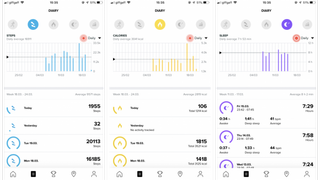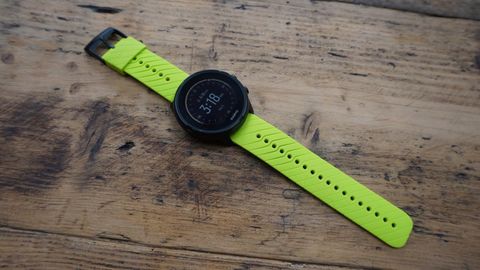Our Verdict
It’s a good sports watch with clever battery life features, but the heart rate accuracy and annoying software hamstring it, especially compared with Garmin watches that offer more features while also being easier to use.
You can trust Coach
Running with the Suunto 9
Confusion reigned when I started to set up my running mode on the Suunto 9. That’s partly because there are two apps (we’ll get into that mess later), but mostly it’s because Suunto has created a load of different running profiles you can sync to the watch. There’s Running Basic, Intervals, Race, Track and others, but these didn’t suit me, so I naturally began to set up my own running mode, which I’d guess most people willing to spend over £400 on a running watch will want to do. However, that decision limits you to four data screens, one of which is fixed to navigation. In Suunto’s preset modes you get more customisable screens and, crucially, the ability to set up intervals to follow on the watch before you start a run. You can’t do this in your own custom mode, which is ridiculous.
There is also no way to create more complicated structured workouts to follow on the watch, a feature that does appear on Garmin and Polar watches that are much cheaper than the Suunto 9.
So my first impressions weren’t great, but I did like that you can cram in up to seven stats on the screen, plus have a gauge running around the outside showing which heart rate zone you’re in, which is very useful for those looking to keep a run easy or hit a threshold zone mid run.
Unfortunately I found that the device’s heart rate tracking is useless while running. The Suunto 9 locked on to my cadence every time I ran and so had me in the max heart zone at all times, skewing other stats like recovery time as well. This is something I’ve experienced with every Suunto watch I’ve tried, and although they are not alone in struggling to provide an accurate heart rate from the wrist, the constant cadence lock makes them more useless than most. Unless of course you just want a quick look at your cadence, in which case the zones are pretty handy.
You can pair the watch to a heart rate strap easily, but only over Bluetooth, not ANT+. If you have any interest in heart rate tracking and have your heart set on this watch, budget for a heart rate monitor too.
Once set up with a strap, the experience of running the Suunto 9 is pretty great. Aside from lacking customisable workouts it offers all the stats a runner could want and breadcrumb navigation. The latter is made especially useful by the fact you can quickly create a route in the Suunto app using a map that highlights nearby tracks that are popular with other Suunto users. You don’t get much detail on your surroundings – just orange lines on a back background – but you can make a simple route in seconds and get it on the watch, and the popular routes are especially handy if you like to run when you travel.

You can also create more complicated routes using a proper map on the Sports Tracker website, which links to the newer Suunto app, or the Movescount website, which links to the older Movescount app. However, the Suunto 9 would freeze most of the time when I tried to sync it to the Movescount app, so in reality you need to use the newer app.
All of the above makes the Suunto 9 a solid running watch, but doesn’t really elevate it beyond what you get from devices that cost around £300, especially given the dodgy heart rate tracking and lack of structured workouts. What does mark the 9 out as a premium device, however, is its intelligent battery modes.
On the face of it these are quite basic – you take GPS readings less often and turn off the screen during a run to get more battery life. In the most accurate mode, where a GPS reading is taken every second, a full charge gets you 25 hours of GPS, which can be extended to 50 hours by selecting Endurance mode (a reading every 60 seconds) and 120 hours in Ultra mode, where a reading is taken every 120 seconds and the screen goes dark until you press a button to wake it up.
Other watches offer similar features, but the 9 betters them by making it easy to switch between modes, before or even during a run when it will alert you if you’re running low on juice, and by still providing pretty accurate distance tracking and a map even in Ultra mode. This is down to the FusedTrack features, which uses other sensors in the device to create a map of your run and measure your distance even when GPS readings are only being taken every 120 seconds.
I tried this against a Garmin linked to a footpod on a tough-to-track city run that also involved running laps of a track, which can stymie even GPS devices. In Ultra mode the Suunto measured my run at 15km, remarkably close to the 14.6km the Garmin logged, which really is pretty great considering the route involved. The Polar Vantage V in its best recording mode was actually less accurate than the Suunto in Ultra mode on that route in the past.
This is a great feature that will appeal to ultramarathon runners in particular, although I can’t help but feel that it’s one that most people will never or only very rarely use. I didn’t need it at any point during my time with the watch, because 25 hours of GPS battery life is still great and I wanted the most accurate recording mode possible, which I’d assume most runners would. As a result the Suunto 9’s smartest feature doesn’t do all that much to counter it’ other failings for runners, namely the inaccurate heart rate tracking, bizarre sports mode set-up, and lack of structured workouts. It’s still a great run tracker, but outclassed both by others at its price and even by some cheaper devices.
Cycling with the Suunto 9
There’s not much difference between the various sports modes on the Suunto 9, aside from changing the default stats you see to be more relevant to the activity. he device is a little better at tracking heart rate when cycling than when running – it really does seem to be the foot hitting the ground that throws it off – and it can be linked to power meters and speed/cadence sensors, though only over Bluetooth.
Swimming with the Suunto 9
As you’d expect from a premium multisport watch, the Suunto 9 can track both pool and open-water swims, and has a triathlon mode. Before you start an indoor session you can set the pool size, although the range is limited from 15m to 330m. The upper limit is a little excessive, and the lower one inadequate. One of my local pools is 13m and I’m yet to come across a 330m-long swimming pool.
The heart rate tracker continues recording in the water and it seemed to do a decent job. I didn’t compare it to a chest strap, but the Suunto 9’s recording tallied closely with my effort level – far better than when I used it for running.
During a swim you can set up the data screens to show sport-specific stats like stroke rate and laps, which you can also review afterwards. However, the Suunto app is lacking detail, and you don’t get graphs of stats like your stroke rate over time. Instead you just get heart rate and pace graphs, along with a list of stats where SWOLF is the only swim-specific info. Suunto needs to improve this because it’s far less detail than you get from the likes of Garmin or Polar after a swim.
RECOMMENDED: Best Swimming Watches
Tracking Activity With The Suunto 9
With its sporty look, the Suunto 9 may not be a watch everyone wants to wear at all times – but if you do keep it on your wrist 24/7 you’ll track steps and active calories stats, which are shown for the current day and in a bar chart for the past week. You can also amend your step goal in increments of 1,000 right up to 100,000, and your active calorie target in increments of 50 up to 5,000. In the Suunto app you can see a bar chart of the past four weeks of both metrics, along with your daily average over that period. You can also set this chart to show your weekly, monthly or yearly step and calorie totals.

Sleep Tracking On The Suunto 9
The sleep tracking on the watch is similar to the step and active calorie tracking. You get a snapshot of your total time asleep on the watch itself, and you can then view your totals over recent weeks, months and years in the chart in the app. The detail on a night’s sleep is pretty basic, though – you just get time asleep, time awake and your average heart rate. This is less than you’ll get from Garmin, Polar and Fitbit, all of which provide details of time spent in light, deep or REM sleep, or a graph of your movement throughout the night.
In short, the Suunto 9 will track your sleep, but it lacks enough detail to be truly useful. Although the watch is pretty light and didn’t disturb me during the night when I wore it, I found little incentive to do so and soon relegated it to my bedside table.
The Suunto app
Suunto launched the Suunto app in spring 2018 to start a gradual transition away from the old Movescount platform, which will be closed in summer 2020. This drawn-out approach has caused a lot of confusion and frustration, especially since the Suunto 9 has a habit of freezing if you try to sync it to both apps, or when trying to use Movescount by itself.
My advice is to just use the new app, which is faster to sync and won’t cause the watch to freeze. The new app is perfectly serviceable, even if it lacks the in-depth detail on your activities provided by Movescount.
One feature that definitely made me warm to the Suunto app was its nifty route planner, and the diary section does a smart job of presenting your recent exercise, steps, calories burned, sleep and fitness level (an estimated VO2 max score) in a bar chart showing the past four weeks.
There’s still not a lot of detail in the app on your daily activities and sleep, and although it has added Strava support, the list of apps you can link to it is short. TrainingPeaks, Relive and Endomondo are there, but MapMyRun and many other popular apps aren’t. I’ve no doubt Suunto will eventually get its app firing on all cylinders, but the long transition period will certainly have put off users who can easily turn to the fully developed and easy-to-use Garmin and Polar platforms instead.
How Often Am I Going To Have To Charge It?
Putting aside the clever GPS battery modes on the watch, which can extend its life considerably if you do want to switch to them ahead of a run or cycle, when you leave the watch in its most accurate battery mode, which is what I did the entire time when not testing out the Ultra mode, it clocks in at a fairly standard 25 hours of GPS. I found this translated to about ten days of life when running most days.
Where Can I Wear It Without People Laughing At Me?
The Suunto 9 isn’t ugly by any means, but the large body of the watch is a bit too plasticky and sporty to be something I’d want to wear for all occasions. You can improve things on that front if you swap the silicone band out for one of the textile or leather options in Suunto’s accessories line-up (£45-£75), but the big old chunk of plastic watch remains in place, and the all-black design we tested in wasn’t as good-looking as the Garmin Fenix 5 Plus or Forerunner 645.

Should I Consider Buying Something Else?
The Suunto 9 is a solid sports watch, but aside from its smart battery modes there’s little about it that stands out, making it hard to recommend at its RRP of £449. That puts it in a premium bracket competing with the likes of the Garmin Forerunner 935 (£389.99) and Polar Vantage V (£439). The latter has its problems, but it does at least have a unique feature in being able to track running power from the wrist.
The Suunto 9 is normally available for around £350 but even at that price there are watches that are its equal or even slightly better, including some that can be found at under £300.
You can find the Garmin Forerunner 735XT for under £250 and that offers better sports tracking as well as being easier to use than the Suunto 9. The Coros Apex 46mm is also under £300 and has an incredible 35 hours of GPS battery life. The Apex is limited in only having sports modes for running, cycling and swimming, but it tracks those well and has breadcrumb navigation on board.
Garmin has also recently launched the Forerunner 245 Music, which is also under £300 with memory for 500 songs and the ability to sync with Spotify accounts, all on top of breadcrumb navigation and Garmin’s excellent sports tracking.
In contrast the Suunto offers nothing that’s particularly special, and its most exciting feature – smart battery modes – will mostly go unused during a typical runner’s schedule.
Buy from Suunto | £449

Nick Harris-Fry is a journalist who has been covering health and fitness since 2015. Nick is an avid runner, covering 70-110km a week, which gives him ample opportunity to test a wide range of running shoes and running gear. He is also the chief tester for fitness trackers and running watches, treadmills and exercise bikes, and workout headphones.

“The PBs Have Always Been Secondary, I Just Enjoyed Running”—How Anya Culling Took Two Hours Off Her First London Marathon Time

This Expert PT Recommends Kettlebell Training For Strength, Power And Cardio Gains—And These Are The Six Exercises To Master First

I’ve Run The London Marathon Six Times—Here Are Four Ways To Set-Up Your Garmin Watch For A Better Race
